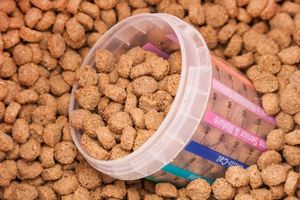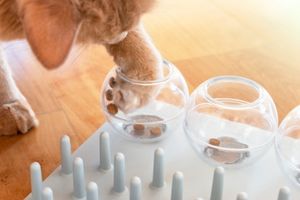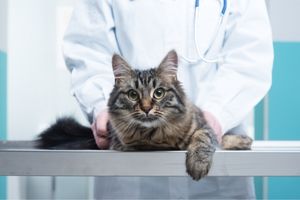According to the Association for Pet Obesity Prevention, roughly 60 percent of cats in the United States are overweight or obese. And while your feline friend looks pretty adorable with some chub, the health issues your chunky cat could suffer from due to their weight are far from cute. Like us, overweight and obese cats are more susceptible to diabetes, heart disease, arthritis, and certain types of cancer than their slimmer counterparts. They tend to have shorter lifespans. Heavier cats can also develop skin issues because they cannot groom themselves properly.
As your cat’s veterinarian, we want to help you give your cat the best, healthiest life possible. We see far too many patients with weight-related health issues and are here to help you keep your cat slim and trim and prevent “fat cat syndrome.” Keep reading to discover how you can partner with your veterinarian to prevent obesity.

Learn About Your Cat’s Dietary Needs
Cats come in many sizes and shapes, so one cat’s ideal weight could be overweight for another. That’s why veterinarians assess cats’ weight using a Body Conditioning Score (BCS) system rather than only putting them on a scale. Ideally, you should be able to see a waistline when looking at your cat from above, and they should have an abdominal tuck — not a belly that nearly drags on the ground. You should be able to feel your feline friend’s ribs easily and see a clear distinction between their shoulders and head.
Assessing your cat using this system enables us to determine whether your cat is overweight based on overall condition, not just the number that pops up on the scale. We can then use this information — along with your answers to questions about their diet and daily routine — to figure out their nutritional needs. If your cat is a bit on the chubby side, there’s a good chance you are feeding them too much or giving them cat food filled with cheap fillers that don’t meet their nutritional needs. Whatever the case may be, we’ll help you understand how much and what type of food to feed your precious pet. Once we point you in the right direction, all of the foods in the pet food aisle will seem a bit less overwhelming.
Don’t Allow Unrestricted Access to Food
Filling up a large bowl or pet food dispenser and leaving it out at all times is convenient. It’s not great for your cat’s health, though. Free-feeding is common among cat owners, but it’s also contributing to obesity. You're not alone if you’ve heard that cats know when to quit eating and won’t overindulge. This misconception has been around for years despite its detrimental effects. Your cat probably won’t scarf down their entire bowl of food in one sitting as a dog might, but they’ll definitely eat more than they should.
Feeding your cat regularly scheduled meals is a much healthier alternative. It may take a little while for them to get used to a new feeding schedule, but they will live a much healthier life if you take away the all-day buffet. As your cat’s veterinarian, we’ll guide you on how much and how often to feed them.

Encourage Exercise
Lack of physical activity is a leading cause of feline obesity — especially among those living strictly indoors. Keeping your cat inside is much safer than letting them venture outside. The only downside is that lazing on the couch all day doesn’t burn calories like wandering around the neighborhood and sniffing out prey.
Fortunately, there are many ways to encourage even the laziest cat to exercise indoors. Playing with your cat a few times each day will keep them physically active and can prevent obesity.
In addition to burning calories, playing with your cat offers several other benefits, including:
- Frequent playtimes prevent boredom.
- Playing with your cat is a wonderful way to strengthen your bond.
- Some toys engage cats’ natural hunting instincts, which is great for indoor cats.
- Playing stimulates cats’ brains and can reduce stress.
You can even turn mealtime into mental and physical exercise by using an interactive puzzle like the one pictured above.
Don’t Be an Automatic Treat Dispenser
We understand that you love your cat and want to make them happy. But feeding them treat after treat isn’t the way to do it. Even if we get your cat on the right track with high-quality food that meets their nutritional needs and an appropriate meal schedule, offering too many treats can derail the entire plan. Instead of grabbing the treat bag when your cat meows at you asking for a snack, reward them with a play session with their favorite toy. Or offer up some head scratches and brushing. Giving your cat too many treats could have roughly the same effect as feeding your toddler a cookie every time they ask for one.

Schedule Routine Wellness Care
Bringing your cat in for routine wellness exams and care is the best way to partner with your veterinarian to prevent obesity. Doing so lets us monitor your cat’s weight and overall health. We may also detect changes in your cat’s condition that you might not notice because you see them every day. And if your cat is packing on extra pounds despite a healthy diet and regular exercise, we may be able to determine the cause with routine bloodwork. Even if they seem healthy, we strongly encourage you to schedule annual wellness exams.
Whether it’s been a while since your cat’s checkup or they need help shedding some excess weight, we are here to help. Contact us today to schedule an appointment for your feline friend.
